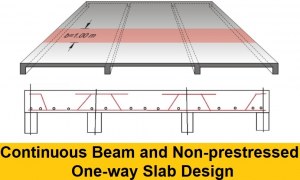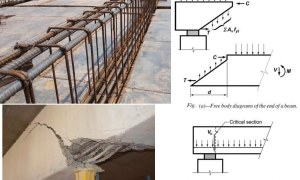🕑 Reading time: 1 minute
There are a number of properties of a beam that an Engineer should be aware of as they dictate beam behaviour when subject to a load and ultimately represent possible areas or mechanisms for failure. The main ones being:- Second moment of area (also referred to as the second moment of inertia): this depends on the cross section profile of the beam and is a measure of the resistance of the shape of the beam to bending.
- Bending moment: usually illustrated on a bending moment diagram, and often related the deflection of the beam, can be used to calculate regions subject to maximum bending forces and consequently most likely to yield. It also illustrates which sections of the beam are in compression or tension.
- Beam deflection: beam deflection tends to be undesirable and correlates to the bending moment.
- Shear diagrams: these are used to illustrate stress concentrations along the beam and provide a means to identify areas of maximum shear forces where the beam is more likely to fail by shear.
 Figure 5 – a) simply supported beam of length l with no force; b) simply supported beam subject to point load (force) F at centre creating bending.
The second moment of area can be calculated from first principles for any cross section profile using the equation:
Figure 5 – a) simply supported beam of length l with no force; b) simply supported beam subject to point load (force) F at centre creating bending.
The second moment of area can be calculated from first principles for any cross section profile using the equation:
 Figure 6 – I-beam cross-section profile with loading parallel to web.
The I – beam or Universal beam has the most efficient cross sectional profile as most of its material is located away from the neutral axis providing a high second moment of area, which in turn increases the stiffness, hence resistance to bending and deflection. It can be calculated using the formula:
Figure 6 – I-beam cross-section profile with loading parallel to web.
The I – beam or Universal beam has the most efficient cross sectional profile as most of its material is located away from the neutral axis providing a high second moment of area, which in turn increases the stiffness, hence resistance to bending and deflection. It can be calculated using the formula:
 As shown in figure 6, this is only suitable for loading parallel to the web, as loading perpendicular to the web would be less efficient.
Box section
As shown in figure 6, this is only suitable for loading parallel to the web, as loading perpendicular to the web would be less efficient.
Box section

Figure 7 – Box section cross-section profile
The box section has the most efficient profile in loading both horizontally and vertically. It has a lower value for second moment of area so is less stiff. It can be calculated by using the formula:


